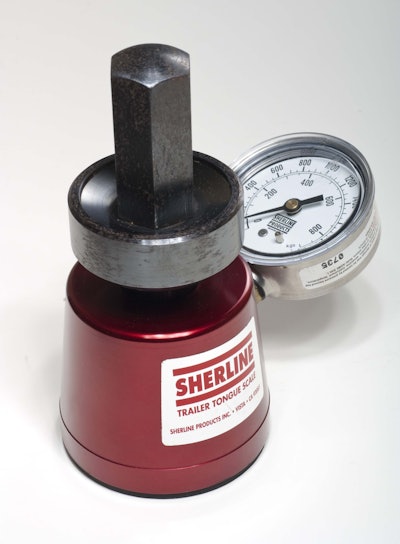
Minding Your Truck’s [tongue] weight; Proper positioning equipment on the trailer is critical to getting the pickup’s tow setup correct and keeping within factory towing guidelines
by Bruce W. Smith/Senior Editor
One of the biggest mistakes work truck drivers make in towing is exceeding the pickup’s maximum hitch tongue weight.
This leads to overloading the truck’s rear suspension, creating significant handling, braking and potentially serious business liability issues.
Moving a piece of equipment, such as a 9,000-pound Bobcat compact loader, six inches forward or back on a tandem-axle equipment trailer can change the tongue weight 600 pounds.
So load positioning is critical if you want to be in compliance with the pickup manufacturers’ towing guidelines.
Every pickup has a set limitation on how much tongue weight can be placed on the hitch (noted in the owner’s manual), and every hitch shank has a load limit (noted on the shank) as to how much it can support.
 Changing the position of a piece of equipment by a few inches can change tongue weight by hundreds of pounds.
Changing the position of a piece of equipment by a few inches can change tongue weight by hundreds of pounds.The two capacities ratings are not always equal, but the lowest number always takes precedence.
For instance, the majority of ½-ton pickups only allow 500 pounds of tongue weight while ¾- and 1-tons with 2-inch receivers generally max out at 1,200 pounds.
The newer HD pickups with 2 1/2-inch receivers are usually rated to support up to 1,700 pounds tongue weight.
Vehicle manufacturers also require 10- to 15 percent of the trailer’s loaded weight on the hitch ball.
So if you are towing a loaded trailer that tips the scales at 9,700 pounds, you should have between 970 and 1,115 pounds on the tongue (hitch ball), with 12- percent being ideal as that gives you a little leeway toward being too heavy or too light.
(Too little tongue weight leads to trailer sway and too much adversely affects the pickup’s braking and steering.)
The easiest way to ensure tongue weight is set in accordance to the pickup manufacturer’s requirements is to use a scale such as those offered by Sherline.
Sherline’s scales are capable of reading tongue weights up to 5,000 pounds, although the 2,000-pound-capacity model is sufficient for most pickup trailer towing applications.
 Sherline scale accurately measures trailer tongue weight.
Sherline scale accurately measures trailer tongue weight.Load the trailer and support it on the trailer jack. Place the scale, resting on a short piece of 2×6, under the trailer coupler and slowly jack it into the coupler until the jack is supporting the weight of the trailer tongue.
Read the dial on the scale. If the weight is too high or too low, adjust the position of the load or equipment on the trailer until the number is correct.
If a piece of equipment is going to be hauled on the same trailer all the time, it’s good to paint or mark the trailer bed to indicate where the bucket edge or a tire needs to be positioned to keep that weight balance correct. – Bruce W. Smith








